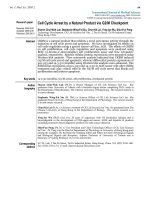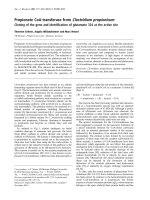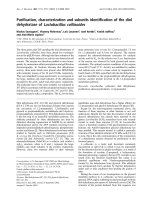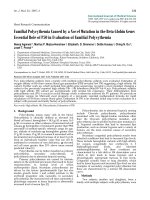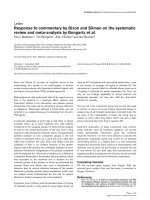Báo cáo y học: " Snapping hip caused by a venous hemangioma of the gluteus maximus muscle: a case report" pptx
Bạn đang xem bản rút gọn của tài liệu. Xem và tải ngay bản đầy đủ của tài liệu tại đây (593.01 KB, 4 trang )
BioMed Central
Page 1 of 4
(page number not for citation purposes)
Journal of Medical Case Reports
Open Access
Case report
Snapping hip caused by a venous hemangioma of the gluteus
maximus muscle: a case report
Cheng-Li Lin, Ming-Tung Huang and Chii-Jeng Lin*
Address: Department of Orthopedics, National Cheng Kung University Medical Center, Tainan, Taiwan
Email: Cheng-Li Lin - ; Ming-Tung Huang - ; Chii-Jeng Lin* -
* Corresponding author
Abstract
Introduction: Snapping hip, or coxa saltans, is defined as a clinical condition where a usually
painful, audible snap occurs during hip flexion and extension. Its causes can be divided into external,
internal or intra-articular origin. Accurate diagnosis is a prerequisite to successful treatment. We
report a rare cause of snapping hip which is different from any previously reported cases.
Case presentation: A 23-year-old man presented to us with right hip pain of more than 10 years
duration. Atrophy of the right gluteus maximus with snapping and tenderness were also noted. The
imaging study revealed a focal intramuscular lesion in the lateral portion of the right gluteus
maximus muscle. Surgery was performed and pathological examination concluded this mass to be
a venous hemangioma.
Conclusion: Intramuscular hemangioma, though rare, should be considered in the differential
diagnosis of a snapping hip even though muscle fibrosis is most frequently encountered.
Introduction
A snapping hip, or coxa saltans, is characterized by a usu-
ally painful snapping phenomenon during hip flexion
and extension. The causes of a snapping hip can be
grouped into external, internal or intra-articular origin
[1]. Since each cause represents a distinct pathogenesis
and may consequently require different surgical interven-
tions, accurate diagnosis is a prerequisite to successful
treatment [2-7].
We report a relatively rare cause of a snapping hip. The eti-
ology of the snapping hip of this 23-year-old man had
been misinterpreted as muscle fibrosis, the most common
cause for this symptom, for more than 10 years. Interest-
ingly, the preoperative assessment and pathological find-
ings were subsequently demonstrated to be different from
any previously reported causes. The cause turned out to be
an intramuscular tumor located close to the gluteus max-
imus insertion around the greater trochanter.
Case presentation
A 23-year-old Taiwanese man, who had suffered from
right hip pain for more than 10 years, requested an ortho-
pedic consultation. He stated that a computed tomogra-
phy (CT) examination 10 years ago for hip pain disclosed
no abnormal findings. However, the hip pain persisted
and radiated to the buttock intermittently, especially
when he adducted and flexed his right hip joint. The pain
could be temporarily relieved by either abduction or the
use of painkiller medication.
On physical examination, atrophy of the right gluteus
maximus with snapping and tenderness of the right hip
was noted. A tight tensor fascia lata without an obvious
Published: 16 December 2008
Journal of Medical Case Reports 2008, 2:386 doi:10.1186/1752-1947-2-386
Received: 10 March 2008
Accepted: 16 December 2008
This article is available from: />© 2008 Lin et al; licensee BioMed Central Ltd.
This is an Open Access article distributed under the terms of the Creative Commons Attribution License ( />),
which permits unrestricted use, distribution, and reproduction in any medium, provided the original work is properly cited.
Journal of Medical Case Reports 2008, 2:386 />Page 2 of 4
(page number not for citation purposes)
palpable mass was suggested. Under the suspicion that
this was not a case of common tensor fascia lata fibrosis,
magnetic resonance imaging (MRI) was arranged and sur-
prisingly revealed a focal intramuscular lesion in the lat-
eral portion of the right gluteus maximus muscle,
approximately 3.5 × 1.5 × 4.4 cm in size, which was
hypointense in T1W and hyperintense in T2W under con-
trast enhancement (Figures 1 and 2).
The patient agreed to surgical management for both the
relief of the symptoms and to determine the pathology of
the lesion. The gluteus maximus muscle was exposed dur-
ing the operation and a hypervascular soft-tissue mass was
noted (Figure 3). We performed surgical excision of the
tumor (Figure 4) and pathological examination con-
cluded this mass to be a venous hemangioma (Figure 5).
The snapping phenomenon was no longer present after
the surgery.
Discussion
The most common type of snapping hip is the external
type caused by the iliotibial band sliding over the greater
trochanter [1,7]. The iliotibial band remains posterior to
the greater trochanter when the hip is extended. As the hip
moves into flexion, the iliotibial band, with assistance
from the underlying bursae, glides smoothly over the
greater trochanter to the anterior position. However,
when the posterior portion of the iliotibial band or the
anterior border with the gluteus maximus becomes thick-
ened, this results in snapping of the tendon over the
greater trochanter [8,9]. In such a case, Z-plasty is the most
common surgical procedure for correcting an external
snapping hip [2,3].
A tumor in the gluteus maximus muscle might mechani-
cally irritate the smooth movement between the iliotibial
band and the greater trochanter, or cause a tight tensor fas-
cia lata, mimicking a snapping hip. However, very few
Magnetic resonance imaging study revealing a focal lesion within the lateral portion of the gluteus maximus muscleFigure 1
Magnetic resonance imaging study revealing a focal lesion
within the lateral portion of the gluteus maximus muscle.
Hypointense signal in T1W is seen under contrast enhance-
ment.
Hypointense signal in T1W under contrast enhancementFigure 2
Hypointense signal in T1W under contrast enhancement.
Operative findingsFigure 3
Operative findings. The soft tissue mass within the gluteus
maximus muscle.
Journal of Medical Case Reports 2008, 2:386 />Page 3 of 4
(page number not for citation purposes)
cases have been reported concerning the relationship
between a local tumor, not of intramuscular origin, and a
snapping hip, except in 2005 when Sanshiro et al.
reported a patient with external snapping hip caused by
an osteochondroma of the proximal femur [10]. The
symptoms disappeared after surgical resection of the oste-
ochondroma.
In our patient, the hemangioma grew in the lateral part of
the gluteus maximus muscle insertion superficial to the
greater trochanter and disturbed the smooth movement
of the iliotibial band over the greater trochanter. Such an
etiology has not been reported before in the literature.
Skeletal muscle hemangioma is probably the most com-
mon form of hemangioma of deep soft tissue, and might
be located in the retroperitoneum, mesentery or muscles
of the lower extremities. Nevertheless, it is rare when con-
sidering the spectrum of benign vascular neoplasms [11].
It accounts for only 0.8% of all hemangiomas and, when
it does occur, it affects the lower extremity most often
[12].
According to histological subtyping, haemangiomas can
be divided into capillary, cavernous and venous types. A
venous hemangioma is rare and is characteristically
present during adult life [13]. Pain is the cardinal symp-
tom occurring in 60% of cases [14]. In our patient, a snap-
ping hip was an extraordinarily rare presentation of a
venous haemangioma. The crucial image modality is MRI
while the choice of treatment is surgical excision [12].
Conclusion
An intramuscular hemangioma, though rare, should be
considered in the differential diagnosis of a snapping hip
even though muscle fibrosis is the most frequent cause.
Consent
Written informed consent was obtained from the patient
for publication of this case report and any accompanying
images. A copy of the written consent is available for
review by the Editor-in-Chief of this journal.
Competing interests
The authors declare that they have no competing interests.
Authors' contributions
CLL collected the patient data, reviewed the literature and
was a major contributor in writing the manuscript. MTH
advised about the writing of the article, interpreted the
clinical significance of the aetiology and participated in
the surgical intervention. CJL was the visiting staff mem-
ber for the patient and was a major contributor in writing
the manuscript. All authors read and approved the final
manuscript.
References
1. Allen WC, Cope R: Coxa saltans: The snapping hip syndrome.
J Am Acad Orthop Surg 1995, 3:303.
2. Brignall CG, Stainsby GD: The snapping hip: treatment by Z-
plasty. J Bone Joint Surg Br 1991, 73:253-254.
3. Provencher MT, Hofmeister EP, Muldoon MP: The surgical treat-
ments of external coxa saltans (the snapping hip) by Z-plasty
of the iliotibial band. Am J Sports Med 2004, 32:470-476.
4. Ilizaliturri VM Jr, Martinez-Escalante FA, Chaidez PA, Camacho-
Galindo J: Endoscopic iliotibial band release for external snap-
ping hip syndrome. Arthroscopy 2006, 22(5):505-510.
5. Gruen GS, Scioscia TN, Lowenstein JE: The surgical treatment of
internal snapping hip. Am J Sports Med 2002, 30:607-613.
6. Ilizaliturri VM Jr, Villalobos FE Jr, Chaidez PA, Valero FS, Aguilera JM:
Internal snapping hip syndrome: treatment by endoscopic
release of the iliopsoas tendon. Arthroscopy 2005,
21(11):1375-1380.
SpecimenFigure 4
Specimen.
PathologyFigure 5
Pathology.
Publish with BioMed Central and every
scientist can read your work free of charge
"BioMed Central will be the most significant development for
disseminating the results of biomedical research in our lifetime."
Sir Paul Nurse, Cancer Research UK
Your research papers will be:
available free of charge to the entire biomedical community
peer reviewed and published immediately upon acceptance
cited in PubMed and archived on PubMed Central
yours — you keep the copyright
Submit your manuscript here:
/>BioMedcentral
Journal of Medical Case Reports 2008, 2:386 />Page 4 of 4
(page number not for citation purposes)
7. Yamamoto Y, Hamada Y, Ide T, Usui I: Arthroscopic surgery to
treat intra-articular type snapping hip. Arthroscopy 2005,
21(9):1120-1125.
8. Nuccion Stephen L, Hunter David M, Finerman Gerald AM: Snap-
ping hip syndrome. Chapter 25 – Hip and Pelvis. In DeLee &
Drez's Orthopaedic Sports Medicine: Principles and Practice 2nd edition.
Edited by: DeLee JC, Drez D, Miller MD. Philadelphia, PA: Saunders;
2003:1447-1448.
9. Scharberg JE, Harper MC, Allen WC: The snapping hip syndrome.
Am J Sports Med 1984, 12:361.
10. Sanshiro I, Yasuo N, Takao M, Shunichi R, Syunsuke H: An external
snapping hip caused by osteochondroma of the proximal
femur. Mod Rheumatol 2005, 15:432-434.
11. Intramuscular hemangioma. In Enzinger and Weiss's Soft Tissue
Tumors 4th edition. Edited by: Weiss SW, Enzinger FM, Goldblum JR.
St. Louis: Mosby; 2001:869-872.
12. Wild AT, Raab P, Krauspe R: Hemangioma of skeletal muscle.
Arch Orthop Trauma Surg 2000, 120:139-143.
13. Weiss SW, Sobin LH, et al.: Histological Typing of Soft Tissue Tumors
Berlin: Springer-Verlag; 1994.
14. Allen PW, Enzinger FM: Hemangioma of skeletal muscle. An
analysis of 89 cases. Cancer 1972, 29:8-22.
